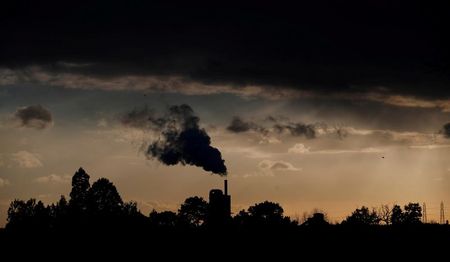
Net Zero: Just Patching Over Emissions or Path for Saving Planet?

More than 190 countries committed in 2015 to limiting global warming to 1.5 degrees Celsius above pre-industrial levels in an effort to stave off the worst effects of climate change such as drought, flooding and loss of species.
Scientists say bringing global carbon dioxide (CO2) emissions to ‘net zero’ by 2050 is the way to meet the central goal of the Paris Agreement, although it was left to individual states to work out how to achieve what they signed up to. Some such as Britain and France have enshrined a net zero 2050 target into law, while many other countries and countless companies have stated policies aiming for net zero by 2050.
On Tuesday the British government published its Net Zero Strategy, which Prime Minister Boris Johnson said would put the country at the vanguard of green economies, forcing competitors such as China and Russia to follow its lead. But what does net zero mean and will it set the world on a path to meeting its Paris goals?
What Does Net Zero Mean?
Net zero does not mean zero emissions but balancing out remaining greenhouse gas emissions with other actions. While countries and companies say they will cut emissions as much as possible, net zero means that some sectors are expected to still be releasing greenhouse gases in 2050.
To offset them, emitters count on projects that cut emissions elsewhere or on using natural solutions or technology to stop emissions reaching the atmosphere. Natural solutions include planting trees or restoring soil or wetlands, while technical projects include capturing and storing CO2 when it is emitted, or sucking carbon out of the air – all of which have yet to make a difference to the climate, given their use remains relatively small-scale.
Will Trees and Offsets Deliver?
Countless voluntary initiatives have sprung up offering offset certificates based on forestry projects and other nature-based solutions which individuals and corporates can buy. Critics say such offsets are a fig-leaf for continued fossil fuel consumption. They point to a lack of common standards and hard-to-verify baselines determining the added climate value of projects underlying offset certificates.
An August report by charity Oxfam said using land alone to remove the world’s carbon emissions to achieve net zero by 2050 would require new forests at least five times the size of India or more than all the farmland on the planet. Proponents say offsets are a useful tool to boost investment in protecting nature while the global economy moves to net zero.
Carbon Capture’s Contribution
Typically carbon capture and storage (CCS) refers to types of filter on industrial smokestacks and projects to store the filtered carbon underground, for example in disused oil fields. Most current CCS projects can decarbonise high-emitting industrial processes. They do not suck any carbon out of the atmosphere but just prevent new carbon from entering. While the technology is proven, global CCS capacity is at only about 40 million tonnes of CO2e.
Negative Emissions?
There is technology that results in negative emissions, for example direct air capture (DAC) or projects that combine bioenergy with technology to capture and store carbon emissions. A June report by the Coalition for Negative Emissions (CNE) said the pipline of projects in development could remove only around 150 million tonnes of CO2 by 2025, making only a tiny dent in global emissions, which hit a record 59.1 billion tonnes in 2020, according to a UN Environment Programme report.
Setting a Carbon Budget
Greenhouse gases are not just made up of CO2 but also gases such as CH4 (methane) and N2O (nitrous oxide), which are often expressed in terms of tonnes of CO2 equivalent or tCO2e. In 2019, atmospheric CO2 concentrations were higher than at any time in at least 2 million years and concentrations of CH4 and N2O were higher than at any time in at least 800,000 years.
Global CO2 equivalent (CO2e) emissions hit a record 59.1 billion tonnes in 2020, the report by the UN Environment Programme said in April. Annual emissions must be cut to 25 billion tonnes CO2e by 2030 to limit the increased global warming to 1.5 degrees Celsius, it said. The Earth’s surface temperature was already 1.09 degrees Celsius higher in 2011–2020 than in 1850–1900. If the world continues on its current trajectory, the rise could be 2 degrees Celsius by 2060 and 2.7 by the century’s end, the Intergovernmental Panel on Climate Change says.
Not Yet Zero?
Apart from much criticism of firms’ reliance on offsets that have yet to materialise, there is no standardised way to lay out net zero strategies and emissions reporting, making holding companies to account difficult. Selling high-emitting assets – a move that can make a company’s emissions report card look better – makes no difference to the planet’s atmosphere if the buyer keeps operating the asset. Both countries and companies are also facing increasing pressure to set detailed, binding intermediate targets on the way to 2050 to avert fears that CEOs and political leaders are just kicking the can down the road.
Prominent climate campaigner Greta Thunberg has criticised net zero goals, counting them among world leaders’ empty promises after years of climate talks.
*************
Disclaimer
The opinions expressed in this article are the author’s own and do not reflect the views of Chanakya Forum. All information provided in this article including timeliness, completeness, accuracy, suitability or validity of information referenced therein, is the sole responsibility of the author. www.chanakyaforum.com does not assume any responsibility for the same.
Chanakya Forum is now on . Click here to join our channel (@ChanakyaForum) and stay updated with the latest headlines and articles.
Important
We work round the clock to bring you the finest articles and updates from around the world. There is a team that works tirelessly to ensure that you have a seamless reading experience. But all this costs money. Please support us so that we keep doing what we do best. Happy Reading
Support Us





















POST COMMENTS (0)